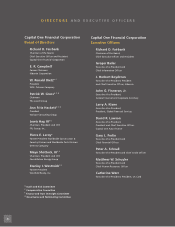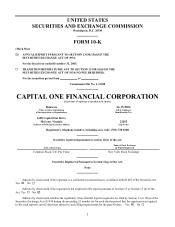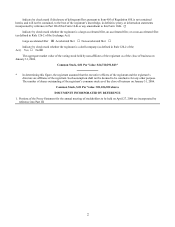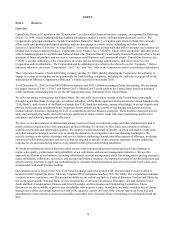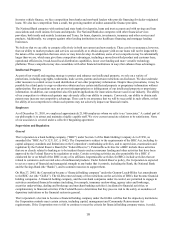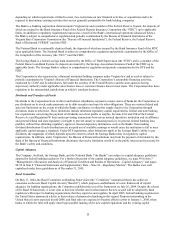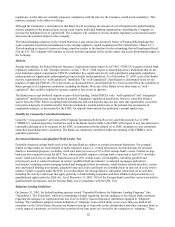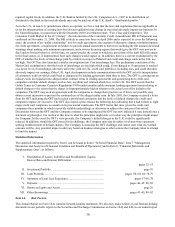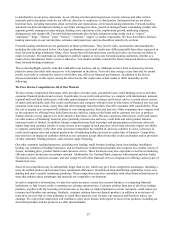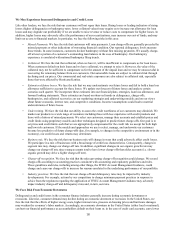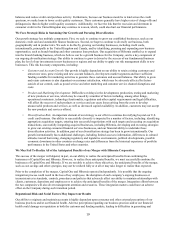Capital One 2005 Annual Report Download - page 19
Download and view the complete annual report
Please find page 19 of the 2005 Capital One annual report below. You can navigate through the pages in the report by either clicking on the pages listed below, or by using the keyword search tool below to find specific information within the annual report.In motor vehicle finance, we face competition from banks and non-bank lenders who provide financing for dealer-originated
loans. We also face competition from a small, but growing number of online automobile finance providers.
The National Bank competes with national and state banks for deposits, loans and trust accounts and with savings and loan
associations and credit unions for loans and deposits. The National Bank also competes with other financial services
providers, both inside and outside Louisiana and Texas, for loans, deposits, investments, insurance and other services and
products. Additionally, we compete against other lending institutions in our healthcare financing and mortgage lending
businesses.
We believe that we are able to compete effectively in both our current and new markets. There can be no assurance, however,
that our ability to market products and services successfully or to obtain adequate yield on our loans will not be impacted by
the nature of the competition that now exists or may later develop. In addition, some of our competitors may be substantially
larger than we are, which may give those competitors advantages, including a more diversified product and customer base,
operational efficiencies, broad-based local distribution capabilities, lower cost funding and more versatile technology
platforms. These competitors may also consolidate with other financial institutions in ways that enhance these advantages.
Intellectual Property
As part of our overall and ongoing strategy to protect and enhance our intellectual property, we rely on a variety of
protections, including copyrights, trademarks, trade secrets, patents and certain restrictions on disclosure. We also undertake
other measures to control access to and distribution of our other proprietary information. Despite these precautions, it may be
possible for a third party to copy or otherwise obtain and use certain intellectual property or proprietary information without
authorization. Our precautions may not prevent misappropriation or infringement of our intellectual property or proprietary
information. In addition, our competitors also file patent applications for innovations that are used in our industry. The ability
of our competitors to obtain such patents may adversely affect our ability to compete. Conversely, our ability to obtain such
patents may increase our competitive advantage. There can be no assurance that we will be successful in such efforts, or that
the ability of our competitors to obtain such patents may not adversely impact our financial results.
Employees
As of December 31, 2005, we employed approximately 21,000 employees whom we refer to as “associates.” A central part of
our philosophy is to attract and maintain a highly capable staff. We view current associate relations to be satisfactory. None
f our associates is covered under a collective bargaining agreement. o
S
upervision and Regulation
G
eneral
The Corporation is a bank holding company (“BHC”) under Section 3 of the Bank Holding Company Act of 1956, as
amended (the “BHC Act”) (12 U.S.C. § 1842). The Corporation is subject to the requirements of the BHC Act, including its
capital adequacy standards and limitations on the Corporation’ s nonbanking activities, and to supervision, examination and
regulation by the Federal Reserve Board (the “Federal Reserve”). Permissible activities for a BHC include those activities
that are so closely related to banking as to be incident thereto such as consumer lending and other activities that have been
approved by the Federal Reserve by regulation or order. Certain servicing activities are also permissible for a BHC if
conducted for or on behalf of the BHC or any of its affiliates. Impermissible activities for BHCs include activities that are
related to commerce such as retail sales of nonfinancial products. Under Federal Reserve policy, the Corporation is expected
to act as a source of financial and managerial strength to any banks that it controls, including the Bank, the National Bank
and the Savings Bank (the “Banks”), and to commit resources to support them.
On May 27, 2005, the Corporation became a “financial holding company” under the Gramm-Leach-Bliley Act amendments
to the BHC Act (the “GLBA”). The GLBA removed many of the restrictions on the activities of BHCs that become financial
holding companies. A financial holding company, and the non-bank companies under its control, are permitted to engage in
activities considered financial in nature (including, for example, insurance underwriting, agency sales and brokerage,
securities underwriting, dealing and brokerage and merchant banking activities); incidental to financial activities; or
complementary to financial activities if the Federal Reserve determines that they pose no risk to the safety or soundness of
depository institutions or the financial system in general.
The Corporation’ s election to become a financial holding company under the GLBA certifies that the depository institutions
the Corporation controls meet certain criteria, including capital, management and Community Reinvestment Act
requirements. If the Corporation were to fail to continue to meet the criteria for financial holding company status, it could,
10


